Policy Instruments Impact on Haiti Agriculture: An Economic Analysis
VerifiedAdded on 2022/11/24
|8
|2233
|52
Report
AI Summary
This report provides an in-depth analysis of the agricultural sector in Haiti, focusing on the challenges faced by small farmers and the impact of various policy instruments. It begins with an introduction highlighting the decreasing agricultural sector due to insufficient land availability and its impact on Haiti's economic growth, which heavily relies on agriculture. The literature review explores existing research on policy reforms, incentive agreements, and conservation efforts, emphasizing the role of economic models in assessing policy changes. The recall section presents data from various tables, comparing farm sizes, income levels, and the effects of taxes and subsidies on land conversion and income. The conclusion summarizes the importance of conservation measures and subsidies, emphasizing the need for cost-effective policies that promote forest conservation and increase farmer income. The report also envisions future research directions, suggesting investigations into the impact of agroforestry development and the long-term benefits of policies. The analysis highlights the implications for farmers and the overall agricultural sector, emphasizing the need for incentives to foster economic growth. Finally, it discusses the data and econometric frameworks required to assess policy changes on farmer income.
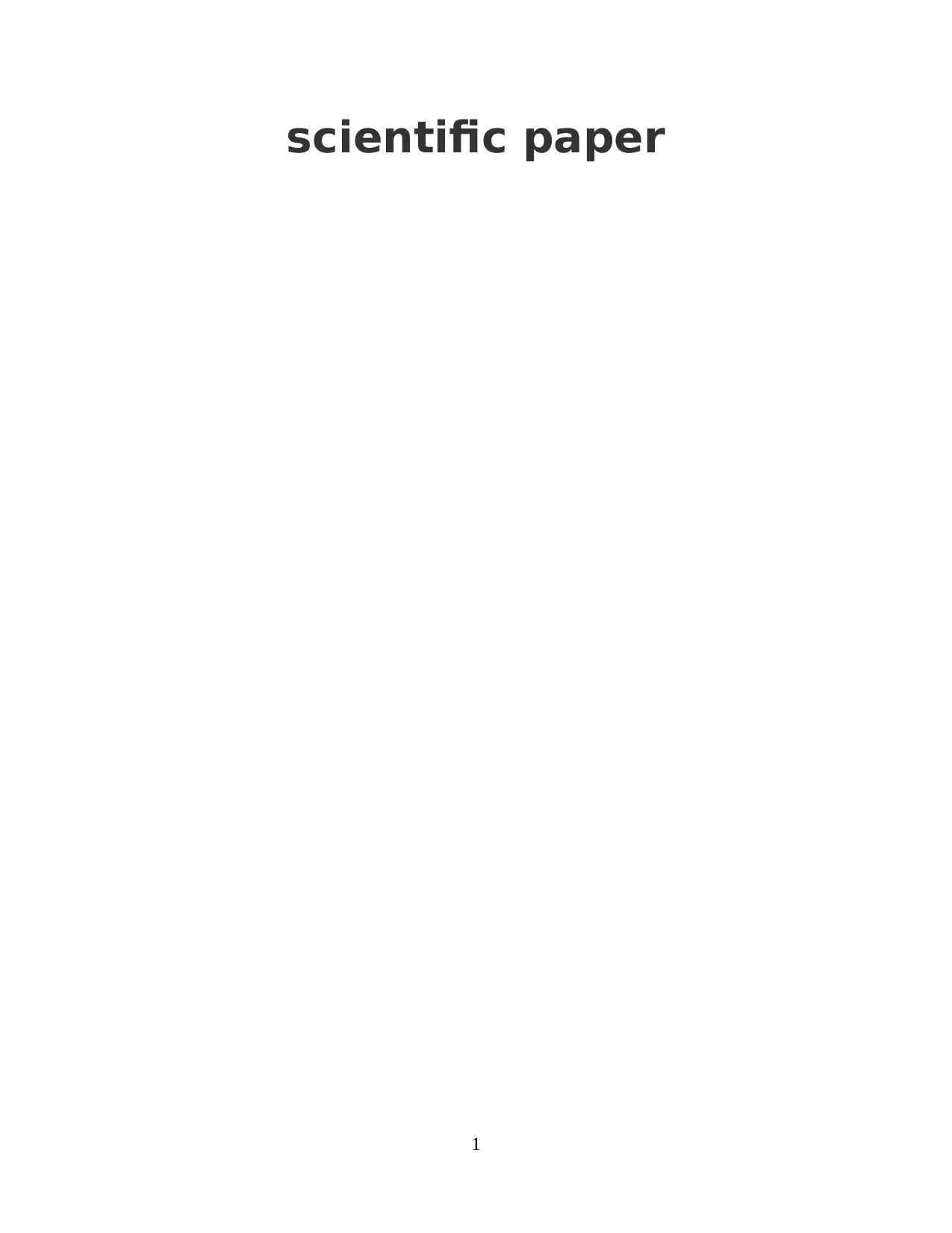
scientific paper
1
1
Paraphrase This Document
Need a fresh take? Get an instant paraphrase of this document with our AI Paraphraser
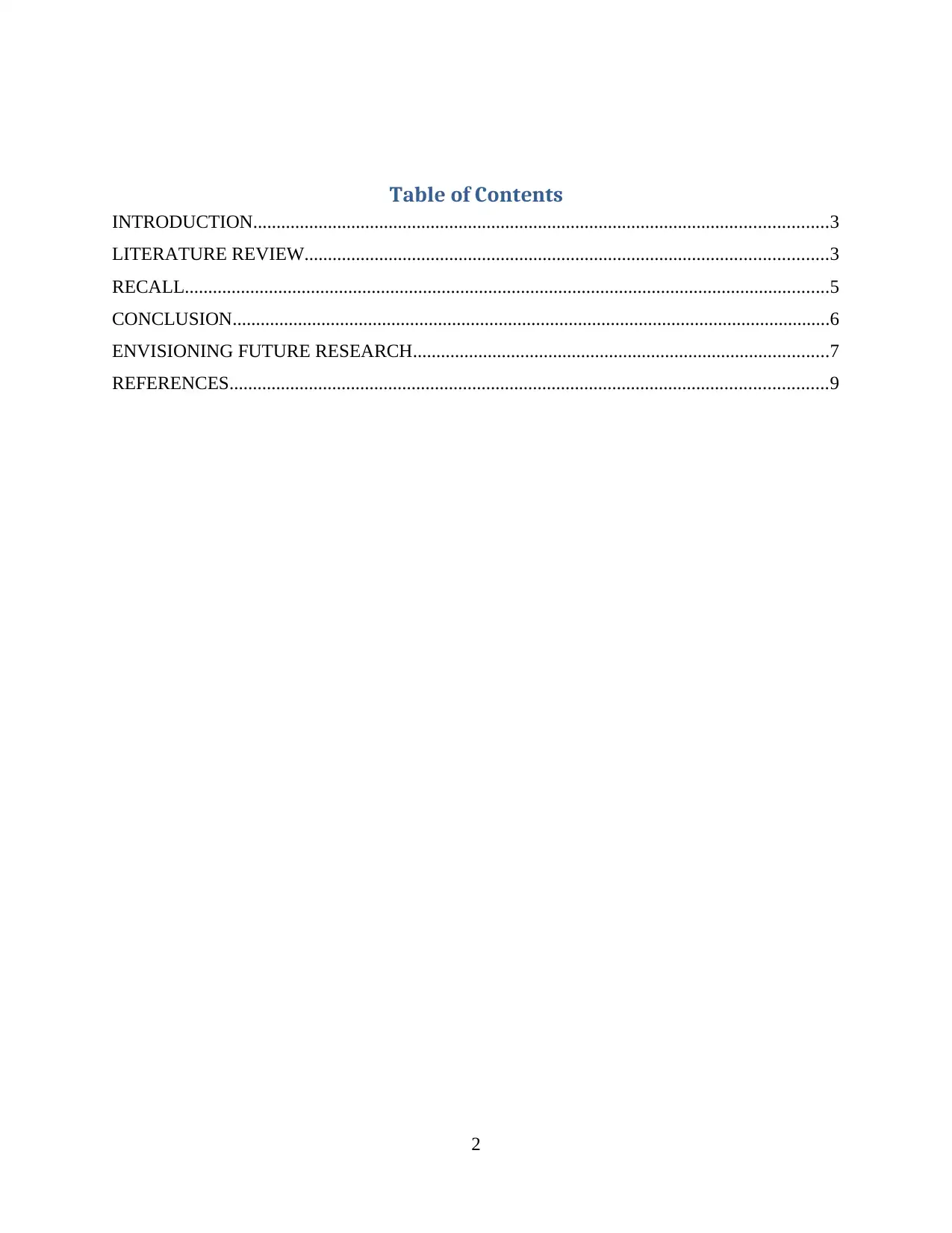
Table of Contents
INTRODUCTION...........................................................................................................................3
LITERATURE REVIEW................................................................................................................3
RECALL..........................................................................................................................................5
CONCLUSION................................................................................................................................6
ENVISIONING FUTURE RESEARCH.........................................................................................7
REFERENCES................................................................................................................................9
2
INTRODUCTION...........................................................................................................................3
LITERATURE REVIEW................................................................................................................3
RECALL..........................................................................................................................................5
CONCLUSION................................................................................................................................6
ENVISIONING FUTURE RESEARCH.........................................................................................7
REFERENCES................................................................................................................................9
2
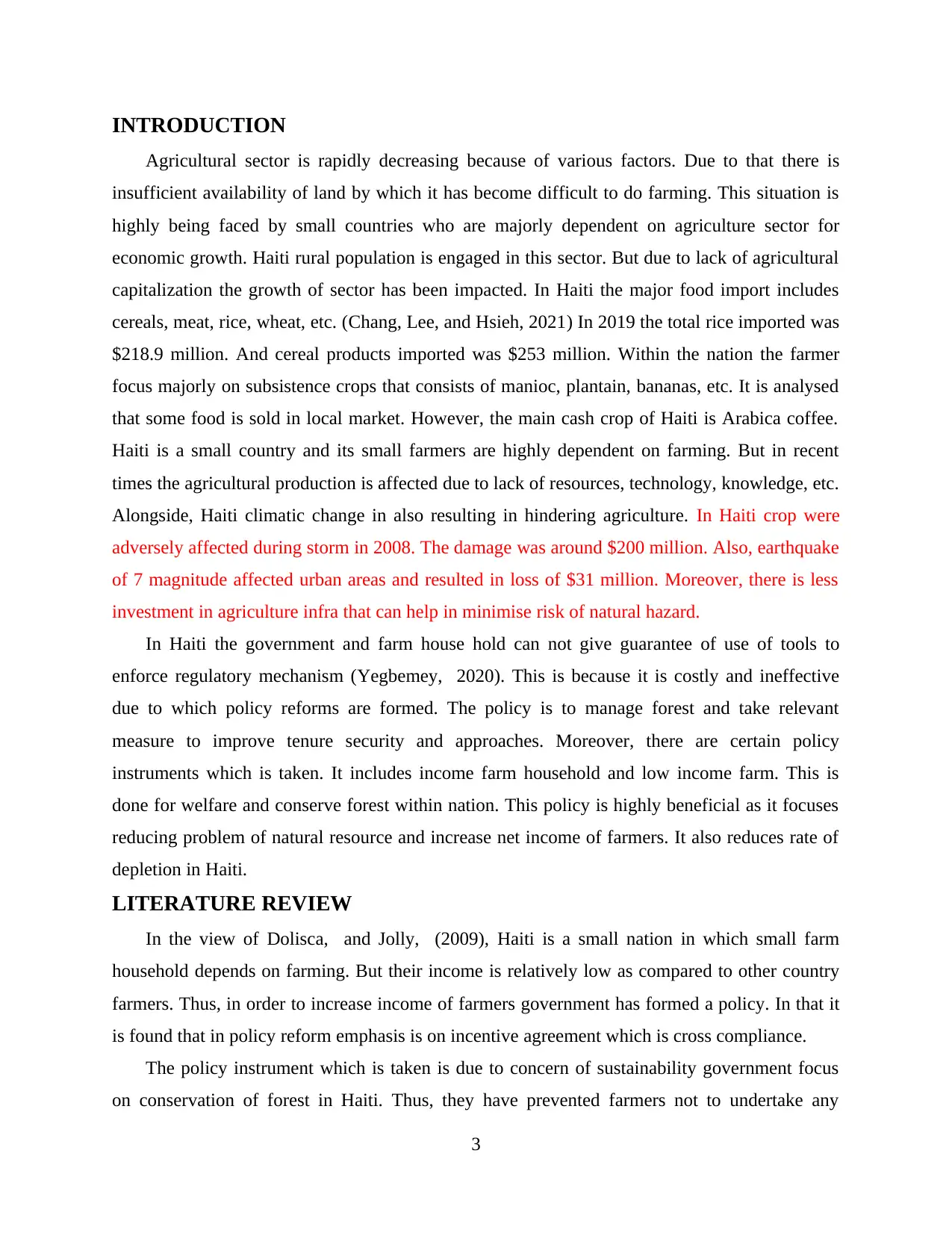
INTRODUCTION
Agricultural sector is rapidly decreasing because of various factors. Due to that there is
insufficient availability of land by which it has become difficult to do farming. This situation is
highly being faced by small countries who are majorly dependent on agriculture sector for
economic growth. Haiti rural population is engaged in this sector. But due to lack of agricultural
capitalization the growth of sector has been impacted. In Haiti the major food import includes
cereals, meat, rice, wheat, etc. (Chang, Lee, and Hsieh, 2021) In 2019 the total rice imported was
$218.9 million. And cereal products imported was $253 million. Within the nation the farmer
focus majorly on subsistence crops that consists of manioc, plantain, bananas, etc. It is analysed
that some food is sold in local market. However, the main cash crop of Haiti is Arabica coffee.
Haiti is a small country and its small farmers are highly dependent on farming. But in recent
times the agricultural production is affected due to lack of resources, technology, knowledge, etc.
Alongside, Haiti climatic change in also resulting in hindering agriculture. In Haiti crop were
adversely affected during storm in 2008. The damage was around $200 million. Also, earthquake
of 7 magnitude affected urban areas and resulted in loss of $31 million. Moreover, there is less
investment in agriculture infra that can help in minimise risk of natural hazard.
In Haiti the government and farm house hold can not give guarantee of use of tools to
enforce regulatory mechanism (Yegbemey, 2020). This is because it is costly and ineffective
due to which policy reforms are formed. The policy is to manage forest and take relevant
measure to improve tenure security and approaches. Moreover, there are certain policy
instruments which is taken. It includes income farm household and low income farm. This is
done for welfare and conserve forest within nation. This policy is highly beneficial as it focuses
reducing problem of natural resource and increase net income of farmers. It also reduces rate of
depletion in Haiti.
LITERATURE REVIEW
In the view of Dolisca, and Jolly, (2009), Haiti is a small nation in which small farm
household depends on farming. But their income is relatively low as compared to other country
farmers. Thus, in order to increase income of farmers government has formed a policy. In that it
is found that in policy reform emphasis is on incentive agreement which is cross compliance.
The policy instrument which is taken is due to concern of sustainability government focus
on conservation of forest in Haiti. Thus, they have prevented farmers not to undertake any
3
Agricultural sector is rapidly decreasing because of various factors. Due to that there is
insufficient availability of land by which it has become difficult to do farming. This situation is
highly being faced by small countries who are majorly dependent on agriculture sector for
economic growth. Haiti rural population is engaged in this sector. But due to lack of agricultural
capitalization the growth of sector has been impacted. In Haiti the major food import includes
cereals, meat, rice, wheat, etc. (Chang, Lee, and Hsieh, 2021) In 2019 the total rice imported was
$218.9 million. And cereal products imported was $253 million. Within the nation the farmer
focus majorly on subsistence crops that consists of manioc, plantain, bananas, etc. It is analysed
that some food is sold in local market. However, the main cash crop of Haiti is Arabica coffee.
Haiti is a small country and its small farmers are highly dependent on farming. But in recent
times the agricultural production is affected due to lack of resources, technology, knowledge, etc.
Alongside, Haiti climatic change in also resulting in hindering agriculture. In Haiti crop were
adversely affected during storm in 2008. The damage was around $200 million. Also, earthquake
of 7 magnitude affected urban areas and resulted in loss of $31 million. Moreover, there is less
investment in agriculture infra that can help in minimise risk of natural hazard.
In Haiti the government and farm house hold can not give guarantee of use of tools to
enforce regulatory mechanism (Yegbemey, 2020). This is because it is costly and ineffective
due to which policy reforms are formed. The policy is to manage forest and take relevant
measure to improve tenure security and approaches. Moreover, there are certain policy
instruments which is taken. It includes income farm household and low income farm. This is
done for welfare and conserve forest within nation. This policy is highly beneficial as it focuses
reducing problem of natural resource and increase net income of farmers. It also reduces rate of
depletion in Haiti.
LITERATURE REVIEW
In the view of Dolisca, and Jolly, (2009), Haiti is a small nation in which small farm
household depends on farming. But their income is relatively low as compared to other country
farmers. Thus, in order to increase income of farmers government has formed a policy. In that it
is found that in policy reform emphasis is on incentive agreement which is cross compliance.
The policy instrument which is taken is due to concern of sustainability government focus
on conservation of forest in Haiti. Thus, they have prevented farmers not to undertake any
3
⊘ This is a preview!⊘
Do you want full access?
Subscribe today to unlock all pages.

Trusted by 1+ million students worldwide
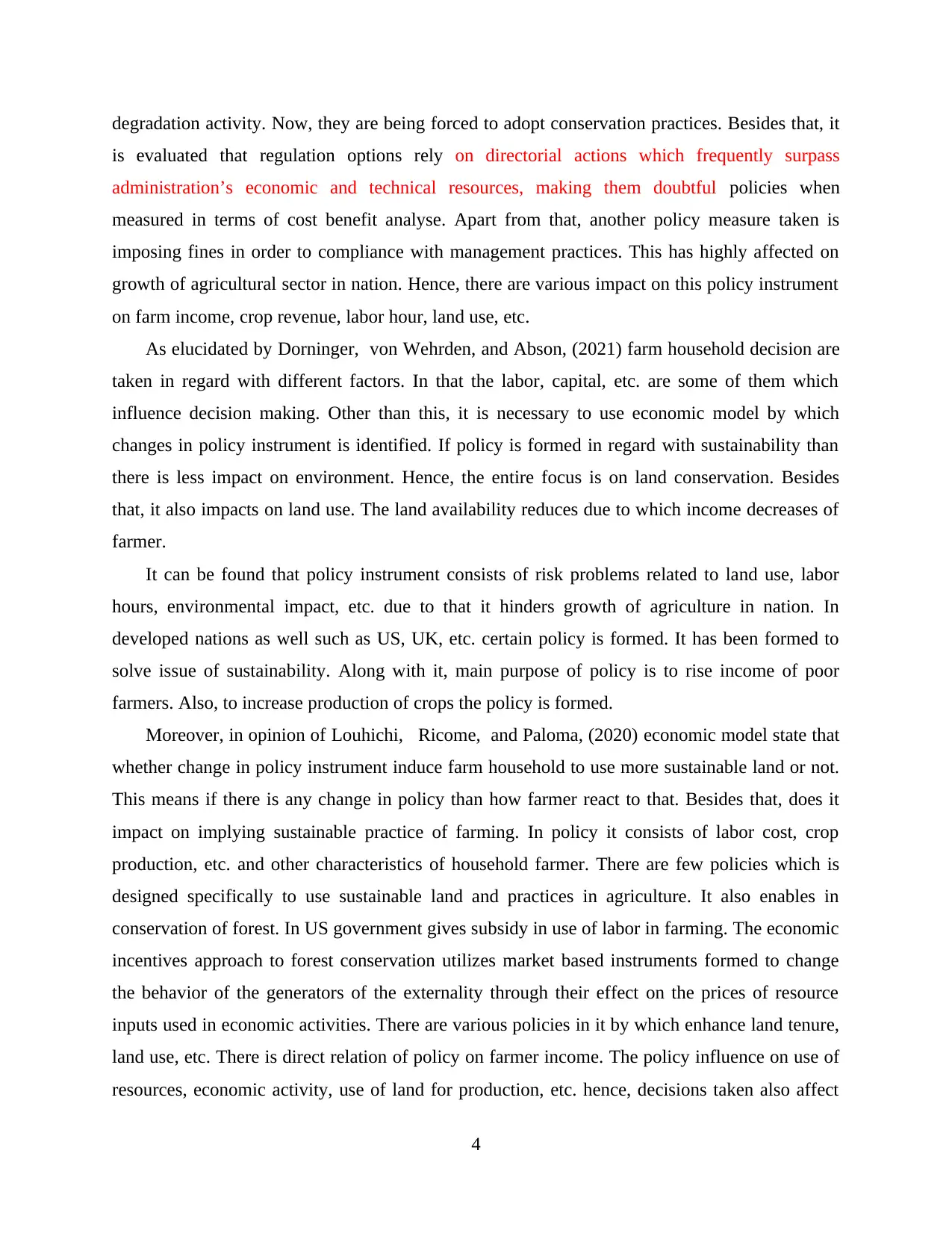
degradation activity. Now, they are being forced to adopt conservation practices. Besides that, it
is evaluated that regulation options rely on directorial actions which frequently surpass
administration’s economic and technical resources, making them doubtful policies when
measured in terms of cost benefit analyse. Apart from that, another policy measure taken is
imposing fines in order to compliance with management practices. This has highly affected on
growth of agricultural sector in nation. Hence, there are various impact on this policy instrument
on farm income, crop revenue, labor hour, land use, etc.
As elucidated by Dorninger, von Wehrden, and Abson, (2021) farm household decision are
taken in regard with different factors. In that the labor, capital, etc. are some of them which
influence decision making. Other than this, it is necessary to use economic model by which
changes in policy instrument is identified. If policy is formed in regard with sustainability than
there is less impact on environment. Hence, the entire focus is on land conservation. Besides
that, it also impacts on land use. The land availability reduces due to which income decreases of
farmer.
It can be found that policy instrument consists of risk problems related to land use, labor
hours, environmental impact, etc. due to that it hinders growth of agriculture in nation. In
developed nations as well such as US, UK, etc. certain policy is formed. It has been formed to
solve issue of sustainability. Along with it, main purpose of policy is to rise income of poor
farmers. Also, to increase production of crops the policy is formed.
Moreover, in opinion of Louhichi, Ricome, and Paloma, (2020) economic model state that
whether change in policy instrument induce farm household to use more sustainable land or not.
This means if there is any change in policy than how farmer react to that. Besides that, does it
impact on implying sustainable practice of farming. In policy it consists of labor cost, crop
production, etc. and other characteristics of household farmer. There are few policies which is
designed specifically to use sustainable land and practices in agriculture. It also enables in
conservation of forest. In US government gives subsidy in use of labor in farming. The economic
incentives approach to forest conservation utilizes market based instruments formed to change
the behavior of the generators of the externality through their effect on the prices of resource
inputs used in economic activities. There are various policies in it by which enhance land tenure,
land use, etc. There is direct relation of policy on farmer income. The policy influence on use of
resources, economic activity, use of land for production, etc. hence, decisions taken also affect
4
is evaluated that regulation options rely on directorial actions which frequently surpass
administration’s economic and technical resources, making them doubtful policies when
measured in terms of cost benefit analyse. Apart from that, another policy measure taken is
imposing fines in order to compliance with management practices. This has highly affected on
growth of agricultural sector in nation. Hence, there are various impact on this policy instrument
on farm income, crop revenue, labor hour, land use, etc.
As elucidated by Dorninger, von Wehrden, and Abson, (2021) farm household decision are
taken in regard with different factors. In that the labor, capital, etc. are some of them which
influence decision making. Other than this, it is necessary to use economic model by which
changes in policy instrument is identified. If policy is formed in regard with sustainability than
there is less impact on environment. Hence, the entire focus is on land conservation. Besides
that, it also impacts on land use. The land availability reduces due to which income decreases of
farmer.
It can be found that policy instrument consists of risk problems related to land use, labor
hours, environmental impact, etc. due to that it hinders growth of agriculture in nation. In
developed nations as well such as US, UK, etc. certain policy is formed. It has been formed to
solve issue of sustainability. Along with it, main purpose of policy is to rise income of poor
farmers. Also, to increase production of crops the policy is formed.
Moreover, in opinion of Louhichi, Ricome, and Paloma, (2020) economic model state that
whether change in policy instrument induce farm household to use more sustainable land or not.
This means if there is any change in policy than how farmer react to that. Besides that, does it
impact on implying sustainable practice of farming. In policy it consists of labor cost, crop
production, etc. and other characteristics of household farmer. There are few policies which is
designed specifically to use sustainable land and practices in agriculture. It also enables in
conservation of forest. In US government gives subsidy in use of labor in farming. The economic
incentives approach to forest conservation utilizes market based instruments formed to change
the behavior of the generators of the externality through their effect on the prices of resource
inputs used in economic activities. There are various policies in it by which enhance land tenure,
land use, etc. There is direct relation of policy on farmer income. The policy influence on use of
resources, economic activity, use of land for production, etc. hence, decisions taken also affect
4
Paraphrase This Document
Need a fresh take? Get an instant paraphrase of this document with our AI Paraphraser
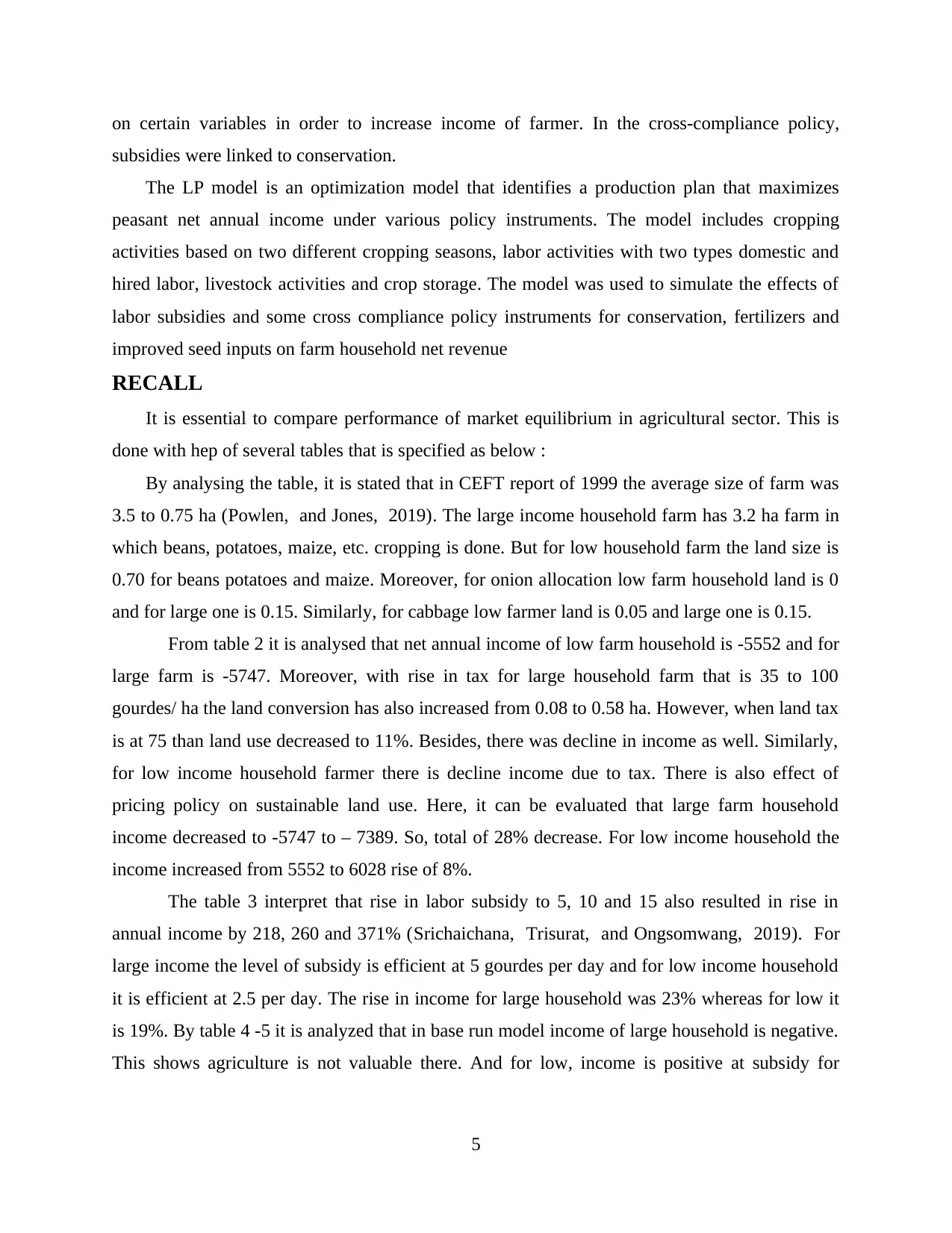
on certain variables in order to increase income of farmer. In the cross-compliance policy,
subsidies were linked to conservation.
The LP model is an optimization model that identifies a production plan that maximizes
peasant net annual income under various policy instruments. The model includes cropping
activities based on two different cropping seasons, labor activities with two types domestic and
hired labor, livestock activities and crop storage. The model was used to simulate the effects of
labor subsidies and some cross compliance policy instruments for conservation, fertilizers and
improved seed inputs on farm household net revenue
RECALL
It is essential to compare performance of market equilibrium in agricultural sector. This is
done with hep of several tables that is specified as below :
By analysing the table, it is stated that in CEFT report of 1999 the average size of farm was
3.5 to 0.75 ha (Powlen, and Jones, 2019). The large income household farm has 3.2 ha farm in
which beans, potatoes, maize, etc. cropping is done. But for low household farm the land size is
0.70 for beans potatoes and maize. Moreover, for onion allocation low farm household land is 0
and for large one is 0.15. Similarly, for cabbage low farmer land is 0.05 and large one is 0.15.
From table 2 it is analysed that net annual income of low farm household is -5552 and for
large farm is -5747. Moreover, with rise in tax for large household farm that is 35 to 100
gourdes/ ha the land conversion has also increased from 0.08 to 0.58 ha. However, when land tax
is at 75 than land use decreased to 11%. Besides, there was decline in income as well. Similarly,
for low income household farmer there is decline income due to tax. There is also effect of
pricing policy on sustainable land use. Here, it can be evaluated that large farm household
income decreased to -5747 to – 7389. So, total of 28% decrease. For low income household the
income increased from 5552 to 6028 rise of 8%.
The table 3 interpret that rise in labor subsidy to 5, 10 and 15 also resulted in rise in
annual income by 218, 260 and 371% (Srichaichana, Trisurat, and Ongsomwang, 2019). For
large income the level of subsidy is efficient at 5 gourdes per day and for low income household
it is efficient at 2.5 per day. The rise in income for large household was 23% whereas for low it
is 19%. By table 4 -5 it is analyzed that in base run model income of large household is negative.
This shows agriculture is not valuable there. And for low, income is positive at subsidy for
5
subsidies were linked to conservation.
The LP model is an optimization model that identifies a production plan that maximizes
peasant net annual income under various policy instruments. The model includes cropping
activities based on two different cropping seasons, labor activities with two types domestic and
hired labor, livestock activities and crop storage. The model was used to simulate the effects of
labor subsidies and some cross compliance policy instruments for conservation, fertilizers and
improved seed inputs on farm household net revenue
RECALL
It is essential to compare performance of market equilibrium in agricultural sector. This is
done with hep of several tables that is specified as below :
By analysing the table, it is stated that in CEFT report of 1999 the average size of farm was
3.5 to 0.75 ha (Powlen, and Jones, 2019). The large income household farm has 3.2 ha farm in
which beans, potatoes, maize, etc. cropping is done. But for low household farm the land size is
0.70 for beans potatoes and maize. Moreover, for onion allocation low farm household land is 0
and for large one is 0.15. Similarly, for cabbage low farmer land is 0.05 and large one is 0.15.
From table 2 it is analysed that net annual income of low farm household is -5552 and for
large farm is -5747. Moreover, with rise in tax for large household farm that is 35 to 100
gourdes/ ha the land conversion has also increased from 0.08 to 0.58 ha. However, when land tax
is at 75 than land use decreased to 11%. Besides, there was decline in income as well. Similarly,
for low income household farmer there is decline income due to tax. There is also effect of
pricing policy on sustainable land use. Here, it can be evaluated that large farm household
income decreased to -5747 to – 7389. So, total of 28% decrease. For low income household the
income increased from 5552 to 6028 rise of 8%.
The table 3 interpret that rise in labor subsidy to 5, 10 and 15 also resulted in rise in
annual income by 218, 260 and 371% (Srichaichana, Trisurat, and Ongsomwang, 2019). For
large income the level of subsidy is efficient at 5 gourdes per day and for low income household
it is efficient at 2.5 per day. The rise in income for large household was 23% whereas for low it
is 19%. By table 4 -5 it is analyzed that in base run model income of large household is negative.
This shows agriculture is not valuable there. And for low, income is positive at subsidy for
5
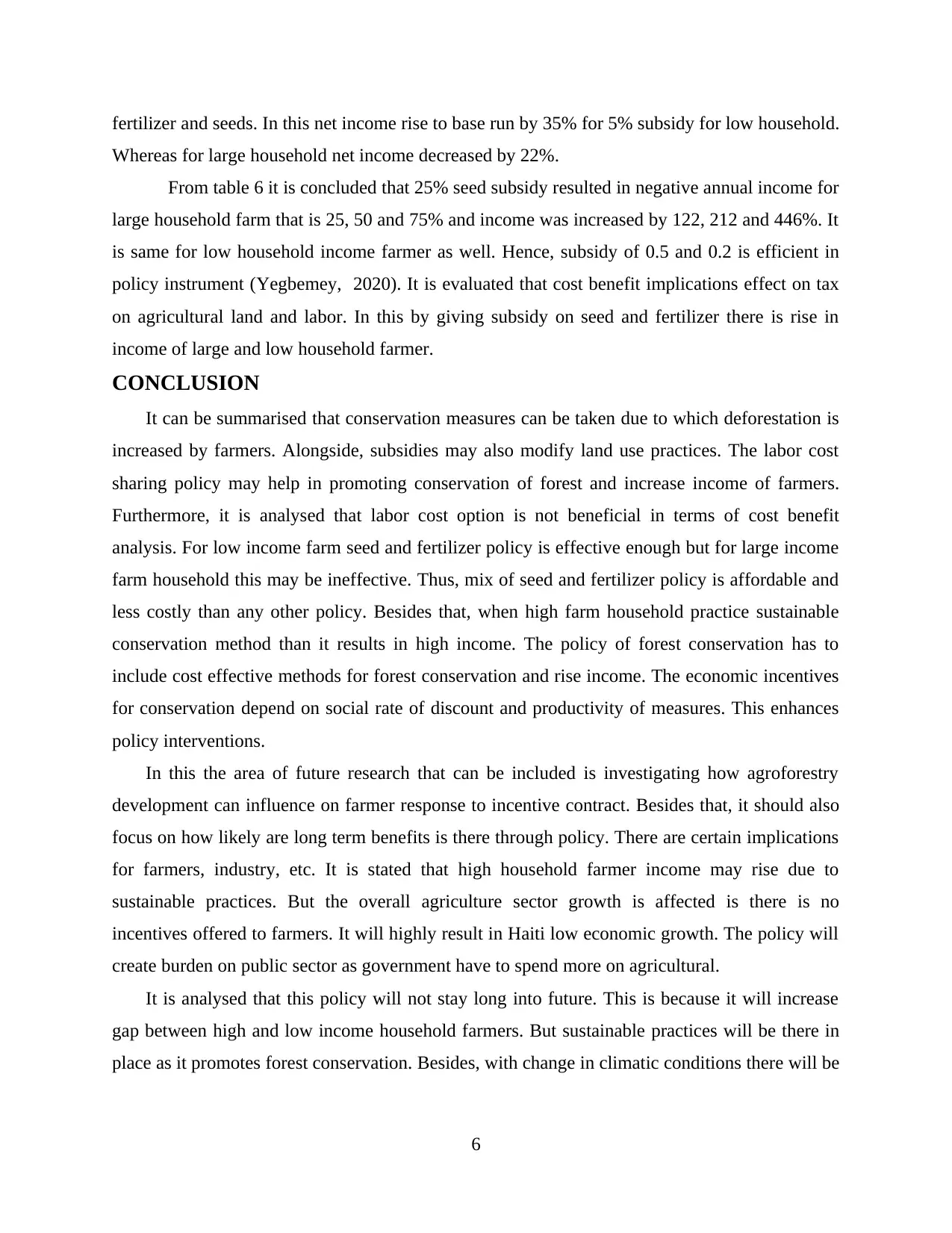
fertilizer and seeds. In this net income rise to base run by 35% for 5% subsidy for low household.
Whereas for large household net income decreased by 22%.
From table 6 it is concluded that 25% seed subsidy resulted in negative annual income for
large household farm that is 25, 50 and 75% and income was increased by 122, 212 and 446%. It
is same for low household income farmer as well. Hence, subsidy of 0.5 and 0.2 is efficient in
policy instrument (Yegbemey, 2020). It is evaluated that cost benefit implications effect on tax
on agricultural land and labor. In this by giving subsidy on seed and fertilizer there is rise in
income of large and low household farmer.
CONCLUSION
It can be summarised that conservation measures can be taken due to which deforestation is
increased by farmers. Alongside, subsidies may also modify land use practices. The labor cost
sharing policy may help in promoting conservation of forest and increase income of farmers.
Furthermore, it is analysed that labor cost option is not beneficial in terms of cost benefit
analysis. For low income farm seed and fertilizer policy is effective enough but for large income
farm household this may be ineffective. Thus, mix of seed and fertilizer policy is affordable and
less costly than any other policy. Besides that, when high farm household practice sustainable
conservation method than it results in high income. The policy of forest conservation has to
include cost effective methods for forest conservation and rise income. The economic incentives
for conservation depend on social rate of discount and productivity of measures. This enhances
policy interventions.
In this the area of future research that can be included is investigating how agroforestry
development can influence on farmer response to incentive contract. Besides that, it should also
focus on how likely are long term benefits is there through policy. There are certain implications
for farmers, industry, etc. It is stated that high household farmer income may rise due to
sustainable practices. But the overall agriculture sector growth is affected is there is no
incentives offered to farmers. It will highly result in Haiti low economic growth. The policy will
create burden on public sector as government have to spend more on agricultural.
It is analysed that this policy will not stay long into future. This is because it will increase
gap between high and low income household farmers. But sustainable practices will be there in
place as it promotes forest conservation. Besides, with change in climatic conditions there will be
6
Whereas for large household net income decreased by 22%.
From table 6 it is concluded that 25% seed subsidy resulted in negative annual income for
large household farm that is 25, 50 and 75% and income was increased by 122, 212 and 446%. It
is same for low household income farmer as well. Hence, subsidy of 0.5 and 0.2 is efficient in
policy instrument (Yegbemey, 2020). It is evaluated that cost benefit implications effect on tax
on agricultural land and labor. In this by giving subsidy on seed and fertilizer there is rise in
income of large and low household farmer.
CONCLUSION
It can be summarised that conservation measures can be taken due to which deforestation is
increased by farmers. Alongside, subsidies may also modify land use practices. The labor cost
sharing policy may help in promoting conservation of forest and increase income of farmers.
Furthermore, it is analysed that labor cost option is not beneficial in terms of cost benefit
analysis. For low income farm seed and fertilizer policy is effective enough but for large income
farm household this may be ineffective. Thus, mix of seed and fertilizer policy is affordable and
less costly than any other policy. Besides that, when high farm household practice sustainable
conservation method than it results in high income. The policy of forest conservation has to
include cost effective methods for forest conservation and rise income. The economic incentives
for conservation depend on social rate of discount and productivity of measures. This enhances
policy interventions.
In this the area of future research that can be included is investigating how agroforestry
development can influence on farmer response to incentive contract. Besides that, it should also
focus on how likely are long term benefits is there through policy. There are certain implications
for farmers, industry, etc. It is stated that high household farmer income may rise due to
sustainable practices. But the overall agriculture sector growth is affected is there is no
incentives offered to farmers. It will highly result in Haiti low economic growth. The policy will
create burden on public sector as government have to spend more on agricultural.
It is analysed that this policy will not stay long into future. This is because it will increase
gap between high and low income household farmers. But sustainable practices will be there in
place as it promotes forest conservation. Besides, with change in climatic conditions there will be
6
⊘ This is a preview!⊘
Do you want full access?
Subscribe today to unlock all pages.

Trusted by 1+ million students worldwide
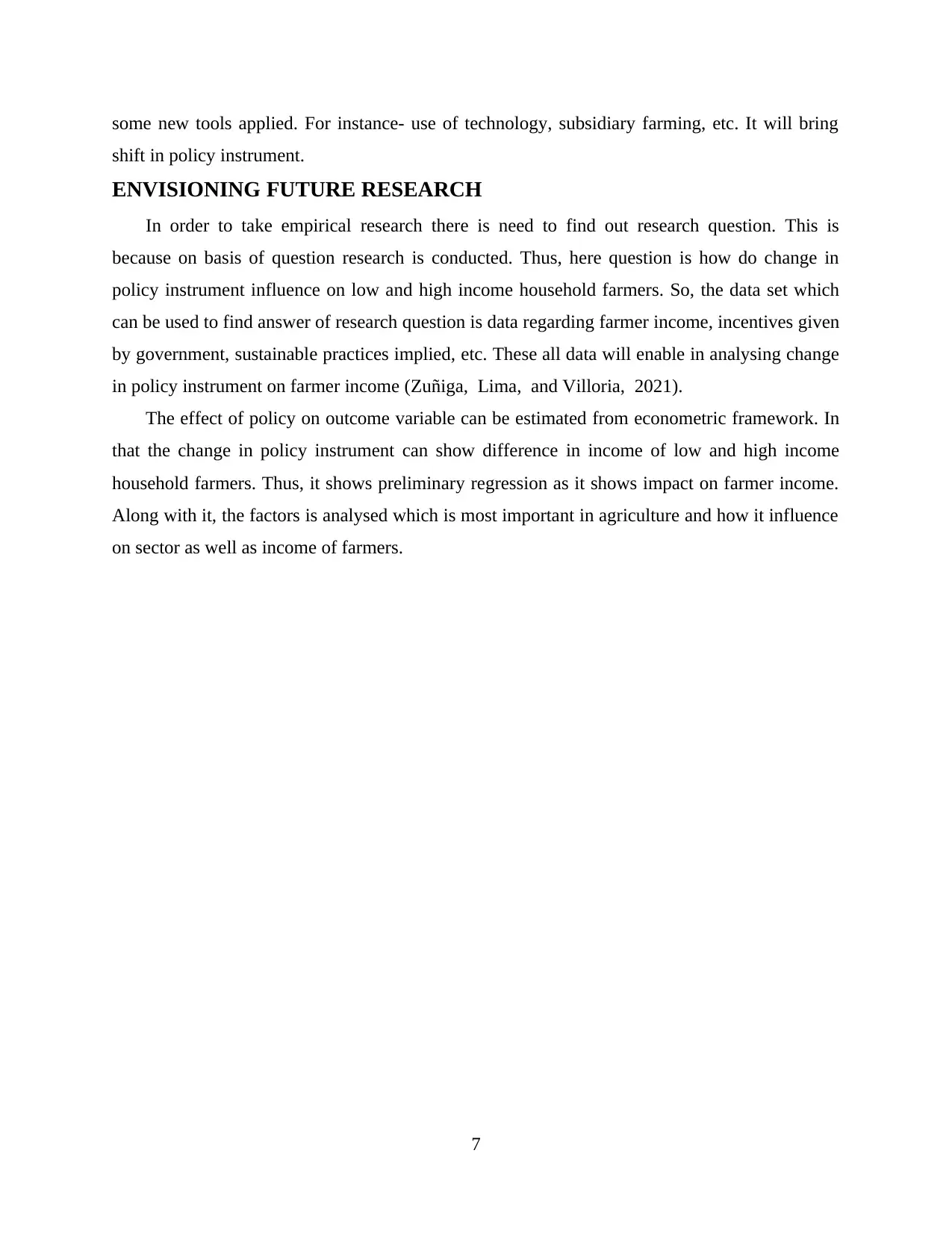
some new tools applied. For instance- use of technology, subsidiary farming, etc. It will bring
shift in policy instrument.
ENVISIONING FUTURE RESEARCH
In order to take empirical research there is need to find out research question. This is
because on basis of question research is conducted. Thus, here question is how do change in
policy instrument influence on low and high income household farmers. So, the data set which
can be used to find answer of research question is data regarding farmer income, incentives given
by government, sustainable practices implied, etc. These all data will enable in analysing change
in policy instrument on farmer income (Zuñiga, Lima, and Villoria, 2021).
The effect of policy on outcome variable can be estimated from econometric framework. In
that the change in policy instrument can show difference in income of low and high income
household farmers. Thus, it shows preliminary regression as it shows impact on farmer income.
Along with it, the factors is analysed which is most important in agriculture and how it influence
on sector as well as income of farmers.
7
shift in policy instrument.
ENVISIONING FUTURE RESEARCH
In order to take empirical research there is need to find out research question. This is
because on basis of question research is conducted. Thus, here question is how do change in
policy instrument influence on low and high income household farmers. So, the data set which
can be used to find answer of research question is data regarding farmer income, incentives given
by government, sustainable practices implied, etc. These all data will enable in analysing change
in policy instrument on farmer income (Zuñiga, Lima, and Villoria, 2021).
The effect of policy on outcome variable can be estimated from econometric framework. In
that the change in policy instrument can show difference in income of low and high income
household farmers. Thus, it shows preliminary regression as it shows impact on farmer income.
Along with it, the factors is analysed which is most important in agriculture and how it influence
on sector as well as income of farmers.
7
Paraphrase This Document
Need a fresh take? Get an instant paraphrase of this document with our AI Paraphraser
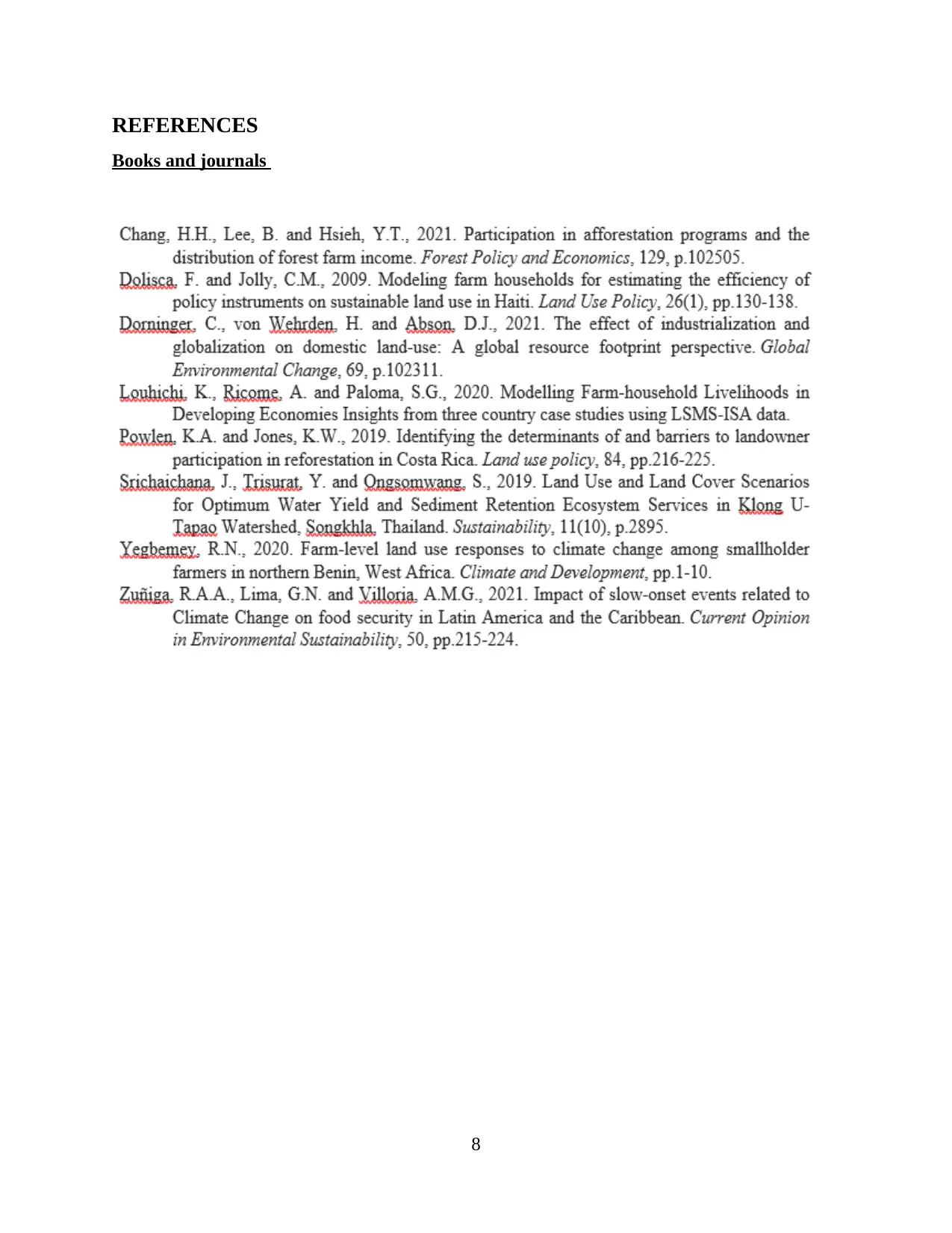
REFERENCES
Books and journals
8
Books and journals
8
1 out of 8
Related Documents
Your All-in-One AI-Powered Toolkit for Academic Success.
+13062052269
info@desklib.com
Available 24*7 on WhatsApp / Email
![[object Object]](/_next/static/media/star-bottom.7253800d.svg)
Unlock your academic potential
Copyright © 2020–2025 A2Z Services. All Rights Reserved. Developed and managed by ZUCOL.





